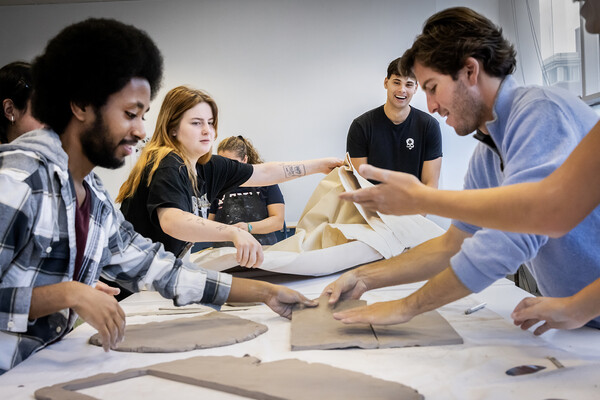A building reborn
On a frigid mid-December morning, Fisher-Bennett Hall looked nothing like a building that would, in a few short weeks, be open for business.
Movers struggled to unload cumbersome desks from a van parked at the front door. The hum of construction buzzed all around. Windows had yet to be installed and more than a few rooms lacked walls.
As he stepped carefully over scattered tools, electrical cords and tubs of drywall mud and surveyed a building still very much a work-in-progress, Tom Ewing didn’t seem the least bit concerned. “We’re confident we’ll be ready on time,” said Ewing, associate director for the School of Arts and Sciences’ Department of Facilities Planning and Operations.
Turns out he was right. After months of extensive rehabilitation, Fisher-Bennett Hall—one of Penn’s most historic buildings—is finally reopening this month, welcoming students for the first time since early 2004. But what they found when they arrived for classes last week was very different from the doddering old building they had left months before.
The renovations have transformed Fisher-Bennett Hall from a crumbling monolith—SAS Dean Rebecca Bushnell once described the building as “inadequate and uncomfortable”—into an architectural gem that features all the benefits of modern design and technology but retains its historic charm. The once cramped, outdated building now offers cozy performance and rehearsal spaces for music students, spacious offices for faculty and state-of-the-art classrooms for the entire University, making it one of the largest central classroom spaces on campus. It also provides a permanent home for the departments of English, Critical Writing and Cinema Studies.
Fisher-Bennett Hall was built in 1925, and at the time of its construction was considered a marvel of design. Over the years, however, the building began to suffer the effects of age. Worse, renovations completed in the 1960s robbed it of much of its early-20th-century character: Ceilings were lowered and, as a result, the building took on a depressing cave-like air.
One of the aims of the renovation was to open Fisher-Bennett up and let natural light flood its halls. “This building had been very dark,” Ewing explains. “One of the big themes here was to increase the light throughout the entire building.”
That effort is apparent immediately on entering the hall’s main entrance. The original staircase still winds upward from the main entrance foyer, as it always has, but the space has been brightened up—and greatly accentuated—by an expansive skylight, four stories up, that throws light throughout the entrance hall. “Before, this ceiling was really down low,” Ewing says. “It looked like somebody’s basement.”
Following the staircase to the fourth floor, visitors will be wowed by a series of spectacular new spaces for the Music Department. From snug rehearsal spaces to a quirky lecture hall to a soaring performance hall, the floor today offers amenities the Music Department has never had. “Everything on the fourth floor was designed with a mind toward the Music Department using it,” says Ewing.
The effort to illuminate the building also can be seen in the basement, where designers made an effort to capture natural light from the street. Behind the building, a new courtyard—created when workers dug up and removed several feet of earth—allowed designers to bring natural light to the basement’s south wall. “The entire building is now amazingly sunny,” Ewing said, “even in the winter.”
A grand opening celebration for Fisher-Bennett Hall will be held at 2 p.m. on Jan. 20. For more information, go to www.sas.upenn.edu/home/news/fisher-bennett.html.








